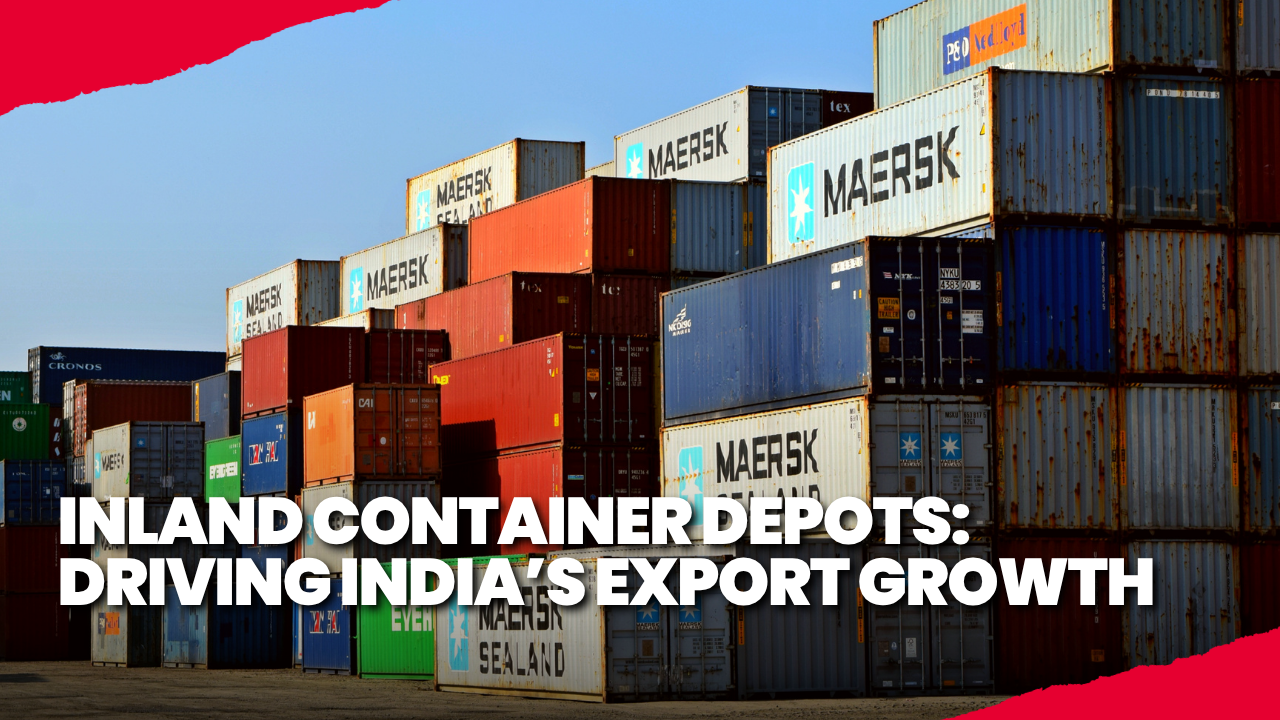
India’s trade network is expanding quickly. The Ministry of Commerce reports that in FY 2023–24, India exported more than 770 billion USD worth of goods and services. Complex logistics systems that link factories in remote regions to global markets are the driving force behind this expansion. However, not all business happens near ports. Many of it is handled inland, at sites called Inland Container Depots (ICDs), which are significant infrastructure items.
There are places away from the usual ocean ports called “dry ports” or “inland container depots.” Handling, keeping, and clearing things before they reach or after they leave seaports happens there. Businesses far from the coast can now get foreign trade services closer than ever with these centers. This makes logistics simpler, less costly, and more effective.
As India is a huge country with a lot of different types of industries, it needs ICDs more than just for convenience. Inland businesses and global shipping routes are connected by them, which helps exporters and importers keep their supply chains running smoothly.
How an Inland Container Depot Operates
An ICD functions as an extension of a seaport. This is how the process usually goes.
1st Step: The closest ICD gets goods from companies or stores. To make shipping more efficient, smaller quantities are combined into full container loads.
2nd Step: As a result, companies can handle paperwork more conveniently when customs officials are stationed at ICDs to process export and import documents.
3rd Step: ICDs offer safe storage for both full and empty containers and offer services like cleaning, repair, and checking of containers.
4th Step: After shipping containers have cleared customs, they are moved to or from ports by rail or road, which facilitates their access to international shipping routes.
It makes trade operations much more efficient for companies in the interior and helps keep ports from getting overloaded.
Importance of Inland Container Depots
ICDs are very important to India’s trade and transportation system in a number of ways. When it comes to customs and documentation, full customs clearance facilities save time and make beach ports less busy.
Working with and keeping containers safely until they are ready to be exported or imported. By combining small packages into bigger loads, cargo consolidation makes transportation more efficient.
Container safety and compliance are guaranteed by regular checks and repairs. ICDs facilitate seamless connectivity by connecting roads, railways, and occasionally waterways. Additional services like marking, packing, and short-term storage make businesses more flexible.
Also Read This: Why MedTech Exports Will Outpace Imports in India by 2032
Advantages of Inland Container Depots
- ICDs help clear out busy seaports by moving paperwork and handling inland, which speeds up the time it takes for ships to return to port.
- Instead of going hundreds of kilometers to a port, businesses can send their goods to the closest ICD. This cut significantly reduces shipping costs.
- Local customs clearance reduces unnecessary delays, which helps companies meet tight export schedules.
- When it comes to foreign trade, ICDs make it easier for landlocked states and smaller manufacturing hubs to take part.
- Local economies get a boost from ICDs because they create jobs in shipping, transportation, warehousing, and other connected fields.
- Logistics are easier to plan and track with ICDs because they use digital tracking and better teamwork between different types of transportation.
Why ICDs matter more to India’s trade strategy
ICDs will be very important for India to reach its goal of becoming a $2 trillion export economy by 2030. As part of plans like PM Gati Shakti and the National Logistics Policy, the government is constantly adding to and improving ICD infrastructure.
With new technologies like IoT-enabled container tracking, automatic gates, and digital customs processes, ICDs will be smarter, faster, and better for the environment.
This will make India’s products more competitive around the world by lowering its total logistics costs, which are currently about 13–14% of its GDP.
Inland Container Depots in India.
To help its trade grow, India has built one of the world’s biggest ICD networks. These centers are spread out across the country to serve important agricultural and manufacturing areas. Some important examples are mentioned below.
- The ICD Tughlakabad (Delhi) is one of the biggest and oldest ones. It is run by CONCOR.
- Double-stack container trains can easily connect to ICD Dadri in Uttar Pradesh, which is a central hub.
- The southern manufacturing and innovation corridor is served by ICD Whitefield (Bengaluru).
- The ICD Bihta (Bihar) helps importers from the eastern part of the country.
- ICD Kottayam (Kerala) is India’s first inland base, which is connected by waterways in the inland water.
These depots are instrumental in the connectivity of inland businesses to significant locations such as Kolkata, Chennai, and Mumbai.
Wrapping It Up
Inland container depots hold together India’s inland trade system. They link industries in distant regions and global markets, increase logistics efficiency, and encourage balanced regional development.
ICDs will continue to be essential links between India’s industrial base and the rest of the world, removing distance as a hurdle to trade success.
FAQs
An ICD is a country dry port where goods are stored, cleared by customs, and sent by road or transport to and from seaports.
They bring shipping and customs services closer to businesses, which reduces costs, wait times, and traffic at seaports.
Each year, more ICDs are built in India, with over 60 functioning ICDs spread out across major agricultural and industrial regions.
Also Checkout Our YouTube Channel: @limeinstituteofexportimport






